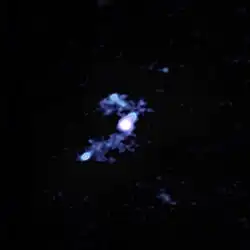WISE J224607.57−052635.0
WISE J224607.57−052635.0 (or W2246−0526 for short)[3] is an extremely luminous infrared galaxy (ELIRG) which, in 2015, was announced as the most luminous known galaxy in the Universe.[3][4][5] The brightness is 350 trillion times[3] that of the Sun (349×1012L☉[1]), and the merger of smaller nearby galaxies may be contributing to its brightness.[3][4][5] The light is generated by a quasar 10 billion times the mass of the Sun. The optical and ultraviolet light emitted by the accretion disc around the quasar's supermassive black hole is absorbed by the galaxy's dust and remitted in the infrared. The galaxy releases 10,000 times more energy than the Milky Way galaxy, although WISE J224607.57–052635.0 is the smaller of the two. WISE J224607.57–052635.0 has a light-travel distance of 12.5 billion light years from it to Earth. The galaxy was discovered using the Wide-field Infrared Survey Explorer.[1][2][6][7][8]
| WISE J224607.57−052635.0 | |
|---|---|
 ALMA image of W2246−0526 merging with three nearby smaller galaxies | |
| Observation data (J2000 epoch) | |
| Constellation | Aquarius |
| Right ascension | 22h 46m 07.57s[1] |
| Declination | −05° 26′ 35.0″[1] |
| Redshift | 4.593[1] |
| Distance | 12.5 billion light-years (3.8 billion parsecs) (light travel distance) [2] 25 billion light-years (7.7 billion parsecs) (comoving distance) |
| Characteristics | |
| Type | LIRG |
| Size | ~150,000 ly (46,000 pc) |
| Apparent size (V) | 0.042 x 0.042 |
| Notable features | Interacting galaxies |
| Other designations | |
| W2246−0526;[3] WISE 2246−0526; WISE J224607.55−052634.9;[3] WISE J224607.56−052634.9,[4] [JBS2014] WJ2246-0526 | |

See also
- SDSS J0100+2802, hyperluminous quasar
References
- Tsai, Chao-Wei; et al. (22 May 2015). "The Most Luminous Galaxies Discovered by WISE". The Astrophysical Journal. 805 (2): 90. arXiv:1410.1751. Bibcode:2015ApJ...805...90T. doi:10.1088/0004-637X/805/2/90. S2CID 39280020.
- Staff (21 May 2015). "WISE spacecraft discovers most luminous galaxy in universe". PhysOrg. Retrieved 22 May 2015.
- Cofield, Calla; Blue, Charles (15 November 2018). "The Most Luminous Galaxy Is Eating Its Neighbors". NASA. Retrieved 15 November 2018.
- Diaz-Santos, T.; et al. (15 November 2018). "The multiple merger assembly of a hyperluminous obscured quasar at redshift 4.6". Science. 362 (6416): 1034–1036. arXiv:1811.05992. Bibcode:2018Sci...362.1034D. doi:10.1126/science.aap7605. PMID 30442765. S2CID 53567900.
- Tsai, Chao-Wei; et al. (14 November 2018). "Super-Eddington Accretion in the WISE-selected Extremely Luminous Infrared Galaxy W2246−0526". The Astrophysical Journal. 868 (1): 15. arXiv:1810.02933. Bibcode:2018ApJ...868...15T. doi:10.3847/1538-4357/aae698. S2CID 119477702.
- "PIA19339: Dusty 'Sunrise' at Core of Galaxy (Artist's Concept)". NASA. 21 May 2015. Retrieved 21 May 2015.
- Chou, Felicia; Clavin, Whitney (21 May 2015). "NASA's WISE Spacecraft Discovers Most Luminous Galaxy in Universe". Retrieved 25 May 2015.
- Lemonick, Michael D. (26 May 2015). "Brightest Galaxy Yet Shines With Light of 300 Trillion Suns". National Geographic News. Retrieved 27 May 2015.
External links
 Media related to WISE J224607.57-052635.0 at Wikimedia Commons
Media related to WISE J224607.57-052635.0 at Wikimedia Commons- SDSS data and images
- Brightest Galaxy Video Scientific American Archived 1 August 2017 at the Wayback Machine
- W2246-0526 on SIMBAD
- W2246-0526 on NASA/IPAC Extragalactic Database


